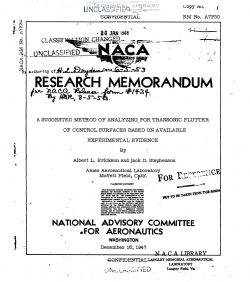naca-rm-a7f30
- Version
- 108 Downloads
- 1.91 MB File Size
- 1 File Count
- April 20, 2017 Create Date
- April 20, 2017 Last Updated
National Advisory Committee for Aeronautics, Research Memorandum - A Suggested Method of Analyzing for Transonic Flutter of Control Surfaces Based on Available Experimental Evidence

This report presents the results of a study of the movement of
shocks on a three-dimensional wing with and without aileron flutter
occurring. The studies inande a number of changes and variations
to the wing and control. From these data and. some basic considerations
of the cause and mechanism of what may be termed "transmic flutter ,“
a tentative method of analysis is developed. The results of the teats
are presented, followed by a general discussion and specific design
recommendations. It is shown that the transonic flutter is caused by
a lag in build—up of the resultant hinge moment due to the velocity
over the wing becoming high enough to retard the change in circula—
tion following control displacement. Under these conditions, the
hinge moment acts .in the direction of the motion for more than one-
11le a complete cycle so that a steady oscillation may exist. From
the analysis it is concluded that controls must be designed with a
large mass moment of inertia or with a high degree of irreversibility
if damping is not used. When a mechanical‘restraining effect is in
the control system, care must be taken in de'sig: of the control system
to insure that the natural frequency of the system is not in the range
of frequencies between one-half the aerodynamic frequency and the
aerodynamic frequency.
Tests of a full—scale partial—span airplane wing were undertaken
in the 16—foot high—speed wind tunnel after an airplane employing this
wing exhibited control—surface vibrations which were associated with
higi—speed flight (reference 1). The vibration was satisfactorily
duplicated in the wind tunnel and was demonstrated to be a new type
of flutter which is the result of the flow velocities in flight at
high subsonic speeds. Because the flutter could not be prevented by
restraining the motion of the wing in bending and torsion, it was
concluded that the surface could maintain steady-or divergent oscila-
tions about its hinge line with only one degree of mechanical freedom,
which proved the existence of a new type of flutter. Flutter was
prevented by restraining the control cables, producing a. condition
which simulates irreversible controls. Damping in the system was also
effective in eliminating all but transient oscillation.
Several useful testing techniques were used. These consisted
of (a) measuring the aerodynamic forces directly by the use of
instantaneous recording pressure cells, (b) measuring the viscous
damping required to prevent the flutter, and (c) photographing the
shock: wave motion and aileron motion by the use of shadowgraphs and
measuring the phase difference between these motions. With the last
arrangement a number of changes to the aerodynamic characteristics
were investigated. Ihis report is concerned primarily with the results
of this investigation. Control—surface flutter is discussed and
certain inferences as to other types of possible transonic flutter
are indicated.
| File | Action |
|---|---|
| naca-rm-a7f30 A Suggested Method of Analyzing for Transonic Flutter of Control Surfaces Based on.pdf | Download |

Comment On This Post